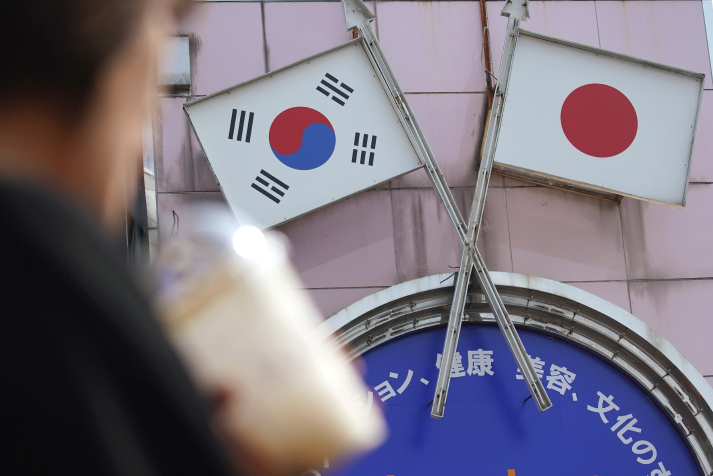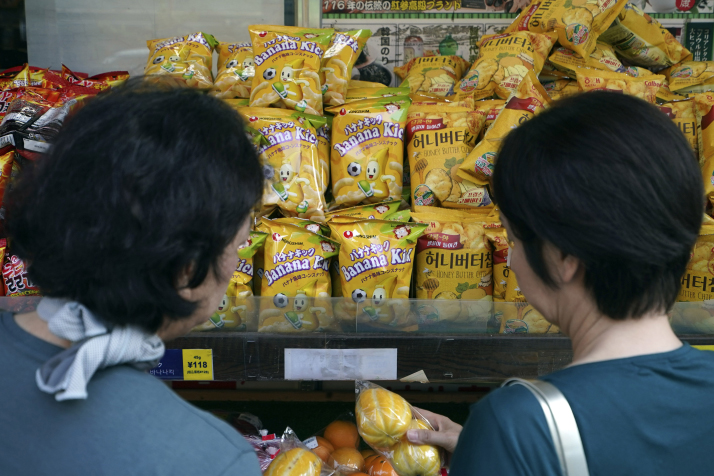| World |
| Storm After Sunshine | |
| The trade dispute between Japan and the ROK threatens much more than bilateral ties | |
|
|
 A pedestrian walks past a billboard bearing the flags of Japan and the Republic of Korea in Tokyo, on August 2 (XINHUA)
A tit-for-tat battle On August 2, Japan's cabinet decided to remove the ROK from its whitelist of preferential trade partners, a first of its kind. In a tit-for-tat move, the ROK also dropped Japan from its whitelist the same day. The trade friction, which partly stems from the continuing disputes on historical issues between the two neighbors, also demonstrates the rivalry for dominance of the hi-tech sector led by 5G communication, quantum technology and artificial intelligence. These three hi-tech battlefields are not only determining a country's global status in science and technology, but also its influence in the field of global economy and trade. The first salvo in this dispute was fired on July 1 when Japan announced restrictions on the sale of Japanese chemicals essential to the ROK's electronic industry. It said exports of the key materials used to make semiconductors and digital displays would have to be approved by its Ministry of Economy, Trade and Industry on a contract-by-contract basis. Leading ROK electronic companies such as Samsung, LG and SK Group have been highly dependent on Japanese chemicals for manufacturing products like television sets and cellphones. The semiconductor industry of the ROK, a pillar industry accounting for 20 percent of the country's total exports, would find it hard not to be impacted if supplies from Japan are cut off. This trade friction could hurt the slowing global semiconductor industry as well. Chip sales globally fell 16.8 percent in the second quarter of 2019 on a year-on-year basis to $98.2 billion, according to statistics from the U.S. Semiconductor Industry Association. The new tension could add to the industry's woes.  Consumers select products made in the Republic of Korea at a store in Tokyo, Japan, on August 2 (XINHUA)
Key growth drivers Since the mid-1980s, trade in the Asia-Pacific region has grown almost twice as fast as global trade, far faster than the zone covered by the North American Free Trade Agreement (NAFTA) or the European Union (EU). A whopping 60-65 percent of Asia's trade volume comes from intermediate products. For most of the Asian economies represented by Japan and the ROK, China mainly acts as a destination for their intermediate exports. China imports semi-finished products and hi-tech parts from developed economies in East Asia and mineral commodities from ASEAN countries. Then the finished goods are exported mostly to developed countries. Trade dependence and integration in the Asia-Pacific region has been on the rise since the beginning of this century. According to the Progress of Asian Economic Integration Annual Report 2019 released at the Boao Forum for Asia Annual Conference in March, Asia's self-dependence rose to 54.2 percent in 2017 from 50.74 percent in 2016. Also, from 2004-17, the Asian economies' dependence on China increased. Notably, developing and emerging economies contributed the most to global trade growth. Particularly, Asian economies' imports grew by as high as 8 percent. If these economies with their different development paces and modes as well as complementary advantages can integrate their markets further, the scale of demand will also increase. By creating favorable conditions for a more complete value chain, these countries can change the traditional trade pattern in South-South or South-North cooperation, forming a new cooperation pattern featuring a more complete value chain within the region. But now, with the new dispute, there could be extensive fallout. Impact on integration Negotiations for the RCEP, the largest FTA under negotiation in Asia accounting for 29.1 percent of global trade and 32.5 percent of global investment, were initiated in 2012 by the 10 ASEAN countries and the bloc's six FTA partners, China, Japan, the ROK, Australia, New Zealand and India. The total population of this grouping is about 3.5 billion with a combined GDP of $23 trillion, or 32.2 percent of the global GDP. After 27 rounds of talks, the participating countries were keen to conclude the pact this year as a way to fend off trade protectionism amid rising trade tensions globally. In the past, developed countries dictated the formulation of global trade rules, as evidenced by the General Agreement on Tariffs and Trade, the World Trade Organization and various FTAs. However, their requirements don't match the development of emerging economies' trade and economy and sometimes, these trade rules have actually been used by the developed countries to contain the development of emerging economies. The RCEP, which includes the world's most promising economies such as China, India and ASEAN, is expected to grow in size and influence once it comes into being, transforming the West-dominated trade pattern into a new one led by emerging economies. However, the escalating tension between Japan and the ROK has left the RCEP facing huge uncertainties. The fate of the China-Japan-ROK FTA also becomes uncertain. It was seen as difficult to achieve, taking a decade for the three countries to start negotiations since proposed in 2002. Then after the first round of talks in 2013, the political relations among the trio suffered several setbacks. But in 2018, driven by thawing China-Japan relations, the three countries agreed to speed up negotiations and so far, 15 rounds of talks have been held. In 2018, the economic volume of China, Japan and the ROK reached $20.95 trillion, exceeding the EU's and drawing close to NAFTA's. However, despite the three countries' total economic strength, their economic integration lags behind the EU's and North America's. China, Japan and the ROK have close economic and trade ties and highly integrated industrial chains. China is the largest trading partner of the other two while Japan and the ROK are China's second and third largest trading partners and the first and second largest sources of investment, respectively. The three neighbors are beneficiaries and active advocates of free trade. Over the past decade, they have accumulated much experience in developing their own free trade zones. However, now even the trilateral FTA might be put on hold or suffer more difficulties with relations between Japan and the ROK deteriorating and their trade dispute escalating. The author is a senior researcher with China Center for International Economic Exchanges Copyedited by Sudeshna Sarkar Comments to yulintao@bjreview.com |
|
||||||||||||||||||||||||||||||
|